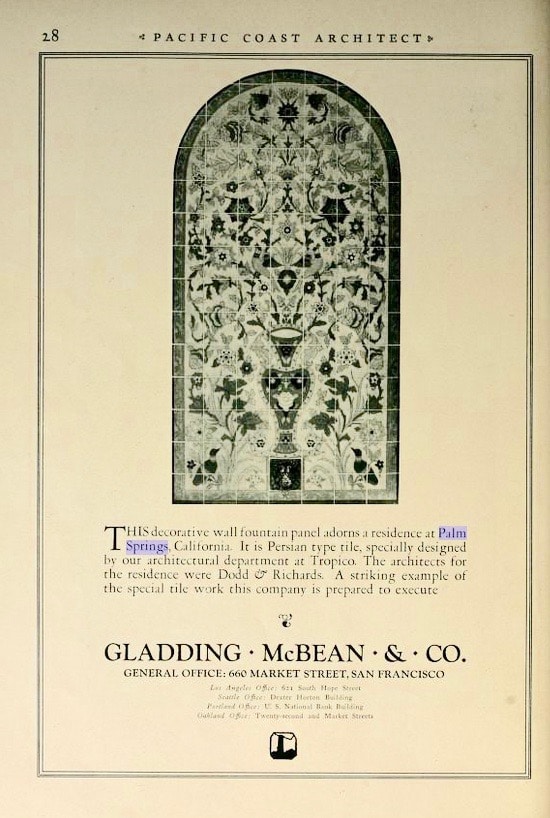
A small advertisement for luxurious art tile appeared in the August 1926 issue of Pacific Coast Monthly. It featured a lavishly decorated tile fountain adorning an outside patio in Palm Springs, California. The Gladding, McBean tile company was well-established by the time of the ad. It had been in business for more than half a century and was known throughout the Southwest.
In the 1920s, architectural terra cotta was all the rage in California. The ornamentation of buildings was decidedly Spanish Revival, and Gladding, McBean was pioneering technology to create ever more fascinating and interesting designs to offer its many customers.
The Founders
Charles Gladding fought for the Union Army in the Civil War. He later moved to Chicago and learned the clay pipe business required, then as now, for sewers. Gladding came west to California in 1874 and read an article in a San Francisco newspaper about a large clay deposit near the town of Lincoln, California. Gladding found the reports to be true; there was an “unusually fine deposit of white kaolin clay” there and located close to the railroad line. Gladding soon partnered with Peter McBean and George Chambers and set up shop in 1875.
Company Evolution
By the 1920s, Gladding, McBean was a major manufacturer and prosperous enough to buy other concerns, starting with the Tropico Potteries in Los Angeles and continuing through multiple other businesses including the LA Pressed Brick Company. With multiple factories and product lines, Gladding, McBean was helping to industrialize the whole of the State of California.
The Great Depression of the following decade was a major blow to business as the demand for building supplies dwindled. Ingeniously, the company sought new products that would still sell, expanding to dinnerware and art pottery. The Franciscan Pottery line was named for the friars who founded the Missions along the length of California. Designed by Mary Grant, the Franciscan Ware patterns of Desert Rose, Franciscan Apple and Franciscan Ivy were markedly different than the solid colored tableware offered by competing firms of Bauer and Catalina Potterie.
The outbreak of World War II caused the cessation of all art pottery production. After the war, fine porcelain imports from Japan became available, and Gladding, McBean went back to industrial production of clay pipe for infrastructure.
Historic Buildings
The company’s products had been used to decorate and embellish thousands of buildings in California, most notably all the major structures of Stanford University which are topped with their iconic Gladding, McBean red tiles, the Spreckles Theater in San Diego and the Ventura County Courthouse.
With all those spectacular buildings from which to choose, it is remarkable that Gladding, McBean selected a small, but exceedingly lovely fountain it had installed in the Bishop House in Palm Springs for its print advertisement in 1926.
The Fountain at the Bishop House
The fountain has been restored to working order and graces the patio outside the dining room at the Bishop House. Nestled against the mountain, the gentle splash it creates is soothing beyond description.
The Willows Historic Palm Springs Inn is expanding to include the Bishop House, built originally as a fraternal twin to the Mead House, called The Willows. The Gladding, McBean fountain at the Bishop House is one of the many reasons it is incredibly lovely here. We look forward to seeing you.